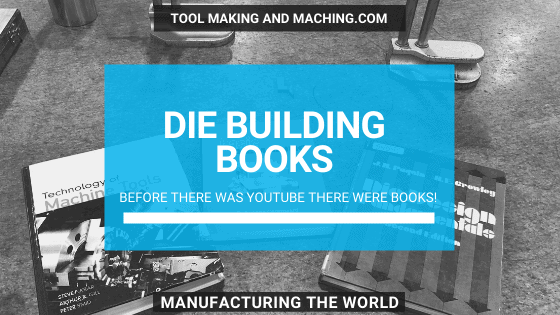Because before youtube you had books
Most of the information on this blog pertaining to die design, die components, or the die build process, which I am using to create my study notes in preparation for my C of Q test, has come from two books. The first one, Basic Diemaking, is an actual textbook from my third-year diemaking course. The second book, Die Design Fundamentals, I got out of personal interest because, I actually found it quite difficult to find books on die design and die building, and this was one of the only ones I could find until I received the course textbook. Hopefully, this summary will help if you are trying to choose a book for yourself. If you’re in school, getting them both is my recommendation.
Basic Diemaking
By D.Eugene Ostergaard
1963 by McGraw-Hill Book Company Inc.
This book is rich in information. It has very thoroughly detailed chapters on each of the components of diemaking. Most of the chapters present the concept of the component and then begin to present several, sometimes what seems too many, variations and alterations to the component. It has many charts and lots of Cad or simplified images of the components being described. The book is comprised of 16 chapters. The first 8 chapters of this book are quite easy and, dare I say, enjoyable to read, in spite of presenting a lot of new and very detailed information. Chapters 9-10 still have a lot of good information, but the writing becomes hard to follow and loses context when describing components and concepts at times, almost as though it was written by a different author. With that being said, it is still a solid book that I would recommend simply because of all the applications and variations to each component it presents, making it a complete die making book.
Die Design Fundamentals
By Vukota Boljanovic, J.R Paquin, R.E. Crowley, Second Edition
1987 by Industrial Press
This was the second book that I used to study in school and to build this blog. I actually read this book before I even started my apprenticeship. Once I got accepted, I wanted to prepare so that I could start with a basic foundation of knowledge, as I am an adult student and not always the best student unless I really apply myself. With that being said, I do highly recommend this book if you’re an enthusiast or just trying to build some simple tooling for yourself. This book is a great start because it keeps things simple and fundamental, as the name suggests. It breaks die design into 14 steps and provides very good illustrations and simple explanations for each step in the die build process. I personally used an old second edition that I bought from a library, but the 3rd edition looks like it has been further updated.
I hope you found this helpful as a recommended reading list or just as a reference whether you are preparing to begin your apprenticeship or studying for your C of Q like myself. If you found this useful, feel free to share and please subscribe to our email list so you can get updates as I put more studying notes up.


